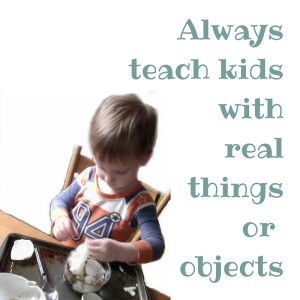A kindergarten teaching career is rewarding and enjoyable and when you understand how young children learn, you’ll have more successful results.
Imagine young children peeking under rocks at the beach. They’re curious, exploring, experimenting, discovering, touching, asking questions, and motivated to learn.
To them it’s all play, they don’t need adults praising them for their efforts, it’s their choice.
So how do we teach in a manner that hooks into this natural desire to learn and use kindergarten teaching methods that encourage, rather than dampen children’s enthusiasm?
Get this concept and the rest is easy…

When teaching kindergarten, always use concrete materials. Children learn best when given things, objects, stuff to learn with (called “concrete objects or manipulatives” in the education speak).
Children need multi-sensory experiences when learning new ideas and concepts.For more information on this topic read, “Teaching with math manipulatives“.
Use science materials like magnets, light paddles, scales, weights, and collections of birds’ nests, book characters and puppets to enhance literacy, and math materials such as pattern blocks, counting objects, and geometric blocks.
Children learn in lots of different ways
Learning styles research tells us that children learn in many ways. Visual learners watch closely when you demonstrate an activity and like to draw and play with shapes and puzzles.
Auditory learners understand ideas and concepts because they remember information they have heard, follow spoken directions well and remember songs easily.
Although all children learn through touch, some learn especially well through touch and movement (tactile/kinetic learners). Some children like structure and some learn more easily in an unstructured environment.
Be aware of learning differences and offer a variety of activities and experiences
If you want your children busy, happy and on task, give them lessons that offer a variety of kindergarten teaching ideas, different opportunities to learn, and things to touch and discover.
Present concepts in a structured step-by-step way
When concepts are presented in a structured step-by-step process with each step building on previous knowledge, children learn with less effort.
Expecting a young child to understand the concept of a food chain without previous experiences with, and vocabulary about, chains and links is assuming too much. Offer step-by-step structured activities and experiences to help kids learn when teaching kindergarten.
Take it slow
During my first practice teaching assignment, I was asked to teach young kids about the metric system. I thought I did a great job.
After the class, my wise, experienced mentor said, “That was great. Now take everything you just taught them and spread it over a three-week period!”
If you’re new to teaching young children, you may be interested in my ebook,Challenging Children to Investigate With Everyday Things. It provides you with the resources to present a new science and math investigation for each week of the year, using simple, affordable, everyday materials like rocks, feathers, fruit, string and branches.